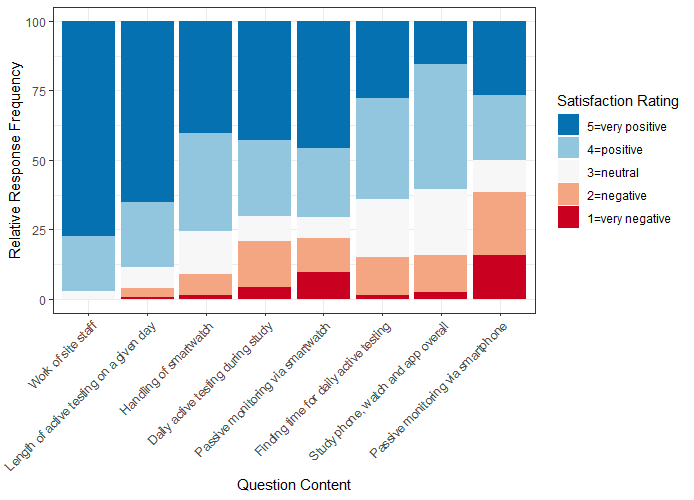Category: Parkinson’s Disease: Clinical Trials
Objective: Extend previous findings from a subset of individuals with early Parkinson’s disease (PD) demonstrating high satisfaction levels with daily remote monitoring with a digital health technology tool (DHTT) and their positive relationship with DHTT adherence.
Background: DHTTs assess PD motor signs objectively, reliably, and frequently. Satisfaction with the DHTT across the studied population is essential to inform data interpretation and future DHTT development.
Method: A total of 316 individuals with early-stage PD in the PASADENA Phase II study (NCT03100149) were remotely monitored over two years with the Roche PD Mobile Application v2, 85% (n=271) of whom completed an end-of-study DHTT satisfaction questionnaire. The DHTT comprised ten active tests, surveys and passive monitoring via smartwatch and -phone. The satisfaction questionnaire included eight 5-point Likert questions on the acceptance of different elements of the DHTT (1=very negative, 3=neutral, 5=very positive), a question on the least preferred component and open feedback. Overall satisfaction was defined as the mean Likert score, with which correlations to adherence and motor sign severity (MDS-UPDRS Part III) were tested.
Results: Overall satisfaction was high (M=3.9, SD=0.7), with the majority of patients positively rating: length of active testing on a given day (89% pos., 4% neg.), daily active testing (70% pos. 21% neg.) and passive monitoring via smartwatch (71% pos., 22% neg.) and -phone (50% pos. 39% neg.) [figure1]. The least preferred component was passive monitoring with provisioned devices (40%). Integrating the app into personal smartphones was noted as an area for future improvement by 15% of patients providing open feedback (n=113). Overall satisfaction correlated with adherence (rs=.40, p<.001) but not with MDS-UPDRS Part III scores (rs=.07, p=.27).
Conclusion: Results confirmed previously reported findings from circa half (53%) of the study population: Acceptance of daily testing over two years in the PASADENA Phase II study remained high, irrespective of motor sign severity, and was associated with adherence. A full DHTT integration into personal devices could further increase satisfaction and adherence. DHTT optimization based on patient input is critical to minimize patient burden and ensure high quality digital outcome measures.
To cite this abstract in AMA style:
B. Fehlmann, A. Thomann, W. Popp, F. Lipsmeier, E. Volkova-Volkmar, J. Friess, H. Svoboda, G. Pagano, T. Kilchemann, A. Bamdadian, W. Zago, R. Postuma, M. Lindemann, K. Taylor. Relationship of satisfaction and adherence in remote digital monitoring: Updated results from a clinical drug trial in early Parkinson’s disease [abstract]. Mov Disord. 2022; 37 (suppl 2). https://www.mdsabstracts.org/abstract/relationship-of-satisfaction-and-adherence-in-remote-digital-monitoring-updated-results-from-a-clinical-drug-trial-in-early-parkinsons-disease/. Accessed March 29, 2025.« Back to 2022 International Congress
MDS Abstracts - https://www.mdsabstracts.org/abstract/relationship-of-satisfaction-and-adherence-in-remote-digital-monitoring-updated-results-from-a-clinical-drug-trial-in-early-parkinsons-disease/

